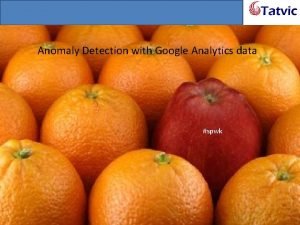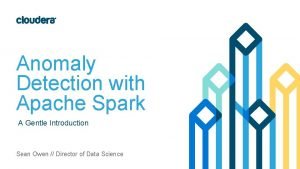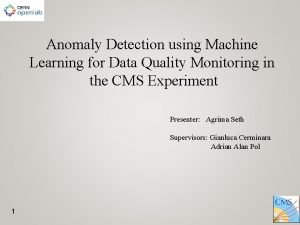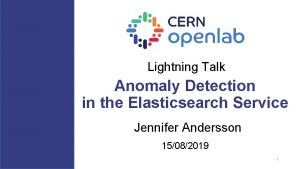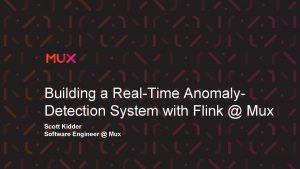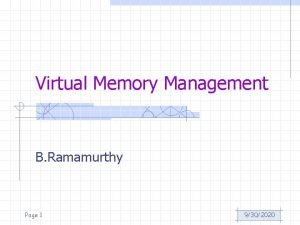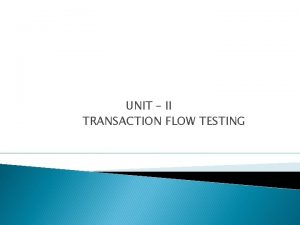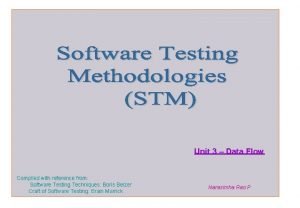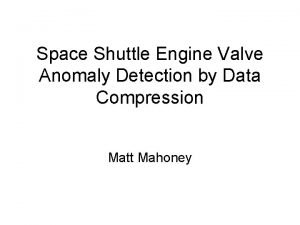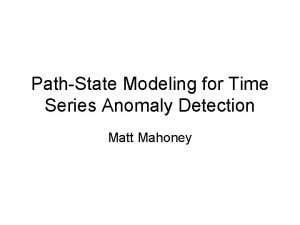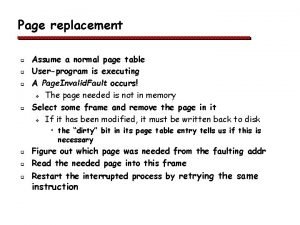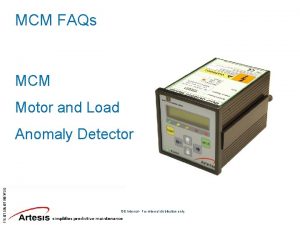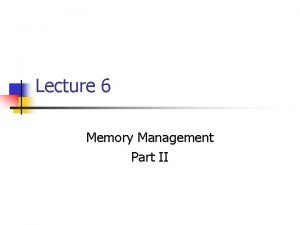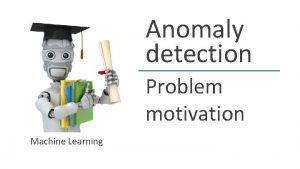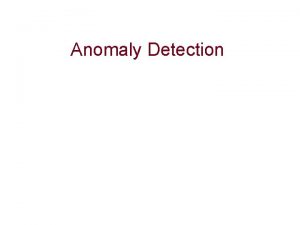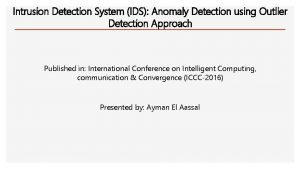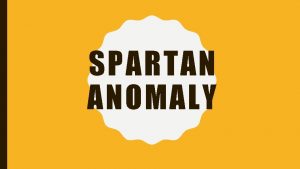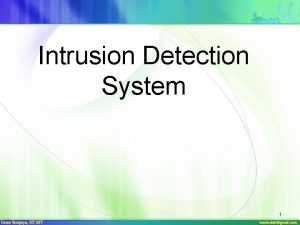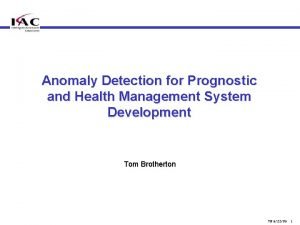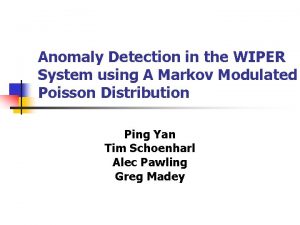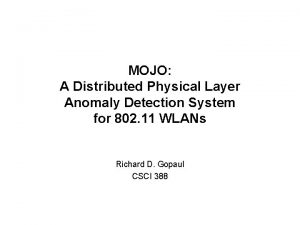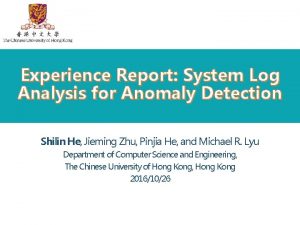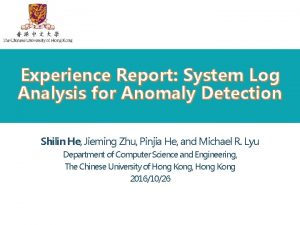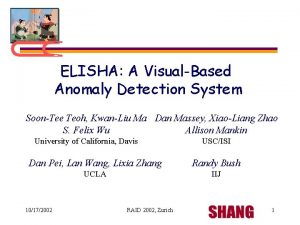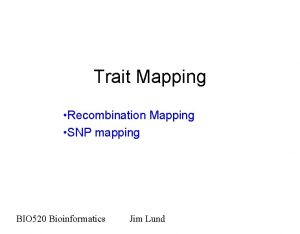Anomaly Detection for the IDEAS Mapping System A
















- Slides: 16

Anomaly Detection for the IDEAS Mapping System A Machine Learning Approach David Meyer Brocade Chief Scientist, VP and Fellow Senior Research Scientist, Computer Science, University of Oregon dmm@{brocade. com, uoregon. edu, 1 -4 -5. net, . . } IDEAS Kickoff Meeting IETF 97 13 – 18 Nov 2016 Seoul, Republic of Korea

Agenda • Potential Use Cases • What Can We Do Today, And What Are The Challenges? • Discussion • Technical explanations/code – https: //github. com/davidmeyer/ml – http: //www. 1 -4 -5. net/~dmm/ml

First, What Does The Scientific Method Look Like When Applied To Machine Learning? Automation meets ML Use Case / problem definition Scripting Hypothesis Design ML Experiment This needs to be fast! HPC, GPUs, … Execute ML Experiment Use cases collected through Research/Customer(s)/others e. g. Autoencoders can detect anomalies in various data sources Prototype environment, variable def. , experimental control, significance, etc. Execute, measure, and update hypothesis if necessary “If you want to increase your success rate, double your failure rate” Thomas Watson Sr. (founder of IBM) Original slide courtesy Armin Wasicek

Prototype Use Case • We want to use Machine Learning (ML) to – Detect anomalous traffic flows that could be malicious • e. g. , DDo. S against the mapping infrastructure – Want to protect the Map Servers and Resolvers • and other system components that could benefit • Map-Registers, Map-Requests, Map-Replies • How might we do this? – – – Collect KPIs from the Map {Server, Resolver} and surrounding infrastructure ETL the data Use ML to Detect Anomalies Remediate Iterate • Proposal: – Occam’s Razor: Do the simplest thing first – Use a simple autoencoder to do binary classification

Agenda • What is the Use Case? • What Can We Do Today, And What Are The Challenges? • Discussion • Technical explanations/code – https: //github. com/davidmeyer/ml – http: //www. 1 -4 -5. net/~dmm/ml

Briefly, What is Anomaly Detection? What’s going on here? • Data don’t fit an explanation model – Impossible, assuming the model is correct • Data do not conform to some normal behavior Clustering - K-means - K-NN -… PCA Autoencoders …. Dimension Reduction We assume that the anomalous data are generated by a different process than our baseline stationary distribution Original slide courtesy Armin Wasicek 6

Autoencoder Example Detecting Anomalies in Handwritten Digits MNIST: 28 x 28 Grayscale Handwritten Digit Dataset • Training set: 55000 images • Test set: 10000 images • Validation set: 5000 images Features here are pixels (28 x 28 = 784) I’m using MNIST here because you easily visualize what is going on. In our case, instead of the input being vectors of {0, 1} we will have vectors Features of here are various counters of map control messages, bandwidth, andother KPIs and other host based KPIs. We can analyze mapping system data in the same way

One Way To Learn To Recognize MNIST: Use An Autoencoder Special Kind of Neural Network 784 Artificial Neurons 100 Artificial Neurons 784 • Key Characteristic: Hidden layer has fewer units than input/output Compression • Goal: Minimize reconstruction (decode) error • • How to define error (loss, cost)? Binary classification: Threshold reconstruction error normal/abnormal • Unsupervised learning

But First: What Does A Single Neuron Do? Dot Product 784 100 784 BTW, how many parameters? 784 x 100 + 100 x 784 = 156800

All Cool, But How Does The Autoencoder Actually Work?

How Hard To Code This Up In Tensorflow? https: //github. com/davidmeyer/ml/blob/master/tensorflow/autoencoder. {py, ipynb}

Autoencoder Output 1 example 10 examples 1000 examples After training, the AE gets low reconstruction error on digits from MNIST and high reconstruction error on everything else: It has learned to recognize MNIST

BTW, How Much Of This Has Been Applied To Networking? • Not too much. Many reasons: • Still early days • Diverse types of network data • Different models for different data types – Flows, logs, various KPIs, … with no obvious way to combine – Incomplete data sets, non-iid data – Network data not designed for ML – Still active area of investigation – Occam’s Razor • Is there a useful “Theory of Network”? – Consider the problem of object recognition/conv nets – Transfer learning • Community challenges: Skill sets, proprietary data sets and use-cases, … – Concern about the probabilistic nature of ML

Next Steps • Build a prototype – Dino • Provide raw data from the LISP mapping system – dmm • process data into appropriate form – Use ML to detect anomalies • Classify anomaly types – Remediation • Frequency hopping idea – Iterate • Get feedback from group • Iterate (again)

Agenda • What is the Use Case? • What Can We Do Today, And What Are The Challenges? • Discussion • Technical explanations/code – https: //github. com/davidmeyer/ml – http: //www. 1 -4 -5. net/~dmm/ml

Q&A Thank you (have more questions/comments? dmm@1 -4 -5. net)
 System log analysis for anomaly detection
System log analysis for anomaly detection Google
Google Anomaly detection spark
Anomaly detection spark Agrima seth
Agrima seth Elasticsearch anomaly detection
Elasticsearch anomaly detection Flink anomaly detection
Flink anomaly detection Memory parameters
Memory parameters Forward mapping vs backward mapping
Forward mapping vs backward mapping Prinsip analisis dan desain
Prinsip analisis dan desain Belady's anomaly example
Belady's anomaly example Transaction flow testing
Transaction flow testing Application of data flow testing
Application of data flow testing Anomaly score
Anomaly score Anomaly score
Anomaly score Belady's anomaly example
Belady's anomaly example Anomaly mcm
Anomaly mcm Least recently used algorithm
Least recently used algorithm

